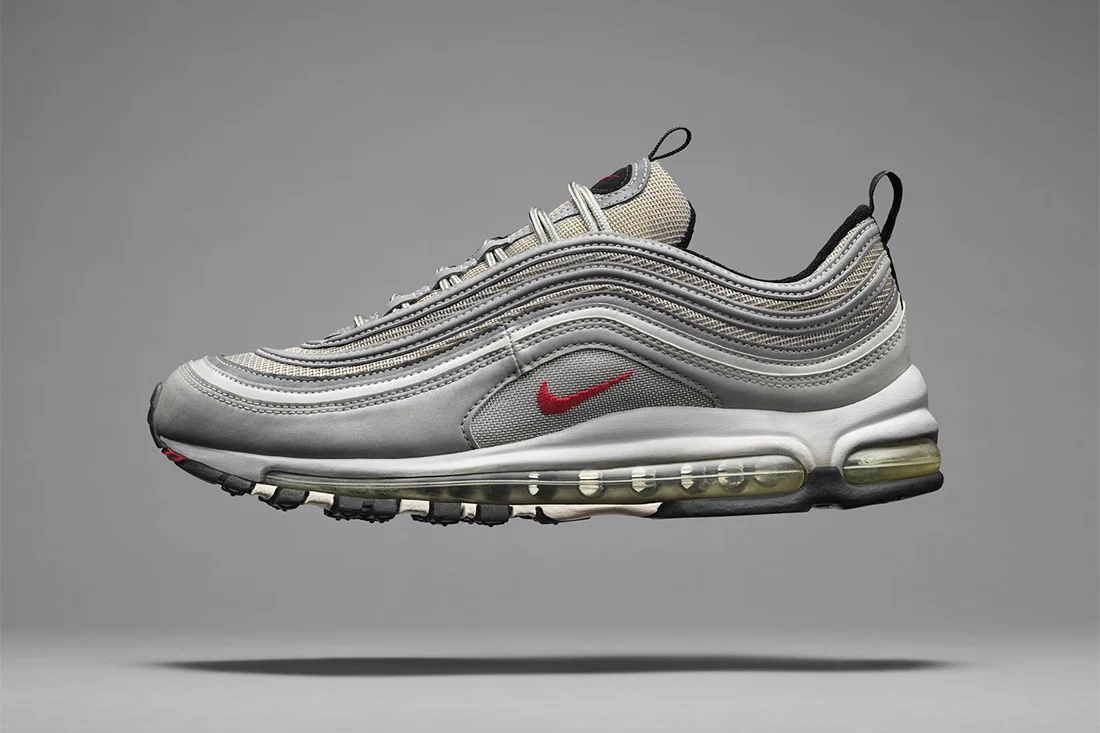AIR MAX 97

In 1997, the film 'Titanic' had just releasedand Celine Dion's 'My Heart Will Go On was annoyingly ringing in the ear of everybody and their moms.The Teletubbies hit the scene hard.
1997 also marks the birth year of one of our favorite sneakers, the Nike Air Max 97.Two years earlier, Nike released the Air Max 95' intending to shift the then basketball sneaker-dominated market back to performance running shoes.
The Air Max 95 was a unique approach to runner cushioning by being the first-ever shoe to feature the visible air unit in the forefoot.It was also the first Air Max model to have a black midsole.
The shoe became a sensation in Japan and Europe. Nike couldn't keep up with the demand. Perhaps that's one of the reasons why the Air Max 96 is so unpopular.
The wild success of its predecessor drowned out all the promotion and advertisement for the 96. By the time 1997 rolled around, both Sergio Lozano and Tinker Hatfield had left the Air Max series to focus on other Nike flagship designs.
The man they left in charge of our beloved Air Max line was the highly talented, young, ex-Reebok employee, Christian Tresser.

In the book 'Le Silver,' a history of the Air Max 97, Tresser talks about his pressure to deliver a seminal design for Nike.
"When the 97 arrived on my desk, it had already been through two designers before me;the message I was given was, This shoe is going to make your career, don't blow it."
Ever since the debut of the Air Max 1, Nike's legendary line had raised expectations in more ways than one. They had brought the runners category to brand new heights. Rather than sitting on retail shelves as niche purchases, running shoes were absorbed by the general public. Nike's marketing showed the world that their shoes were never just shoes. They were what legends wore, runners wore them, but celebrities wore them, too.
Every time Nike released an Air Max, it was remarkable, but they also put a feverish note of anticipation on every release. Nike designers weren't just expected to release innovative runners; they were expected to outdo their own efforts on a consistent and unending basis. With all this pressure that Nike was putting on Christian Tresser, he worked hard on the shoe. Having to work around a brand new total air version visible air unit that spanned the length of the entire midsole, something completely new and challenging to implement into the design.
Now, you have to keep in mind that in 1997 the world was on the verge of entering a new millennium. Everyone was looking ahead in both technology and design. The futuristic-sounding year of 2000 was right around the corner. This optimistic futurism pervaded both industrial and fashion design with sleek curves and metallic chrome accents dominating everything from cars to CD players, mountain bikes, and of course, sneakers.
Christian Tresser took all these influences and used them as inspiration. Tresser's genius allowed him to combine like the ripple of waves on a pond or a raindrop. When you look at the Air Max 97, the design flows from a seamless yet powerful motion of water. A nod to silver bullet trains inspires its beloved of the future and the past.
All of this created a remarkable shoe that resonated with everyone from rappers, like Big Pun, and everyone's favorite Spice Girl, Mel C.
The Nike Air Max 97 was ground-breaking in many ways. It was the first Nike Air Max to be fully foamless. To feature the hidden lace-up system. And just like today, it came at a premium price. The Air Max 97 cost more than its predecessor by a substantial margin, marking the first time the Air Max has changed prices between models. It may not sound like much, but that is the equivalent of $ 225 in 1997, the price that we still believe is above the average cost of most sneakers.
Would you pay $ 150 for sneakers?
The release of the Air Max 97couldn't have been more timely. The $ 150 price tag was of no concern to consumers in 1997.The shoe enjoyed wild success, but unfortunately for the U.S. market, the hype only lasted a year.
If there is one thing that Nike is known for, it is turning out new versions of the same shoe in different colorways with small design tweaks. Not only did this allow them always to have an exciting new shoe to sell, but it also allowed them to make tweaks and designs that were noted as undesirable to the public.
Naturally, Nike wanted to maximize the profits coming in from the Air Max boom that was happening in countries like Japan and Italy. Unfortunately, the Air Max 97 was superseded by the Air Max 98.It didn't quite garner the attention of a trend-setting phenomenon. Though it sold well enough to justify all the work put into its design and production, it just felt like it was missing something.
If it wasn't for Italy's subculture celebrating the shoe the way they did and still do, the Air Max 97 could have very well ended up in a much less prominent place in sneaker culture right now. Luckily, like all old Nike favorites, it has found its way back to the shelves in different variations.
Thanks to the constant retroing of classics, we can now look forward to new and improved versions of the Air Max 97.Thanks to the amazing colorways of the shoe, the Nike Air Max 97 has been rekindled as a favorite amongst sneakerheads today.
Listen to the article
